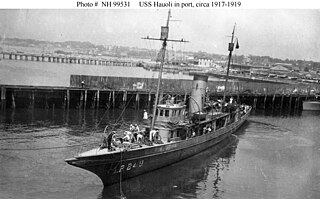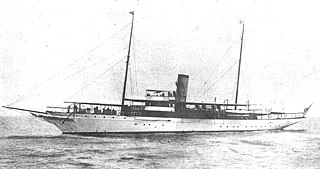
USS Impetuous (PYc-46) was a private yacht purchased by the Navy in August 1940 that served as a patrol boat of the United States Navy in Central America. The yacht was built as Paragon, the first of at least two Davol yachts to bear the name, in 1915 for Charles J. Davol of Providence, Rhode Island. In 1916 Davol sold the yacht to John Fred Betz, 3d of Philadelphia who renamed the yacht Sybilla III which served as the Section Patrol yacht USS Sybilla III (SP-104) from May 1917 to December 1918. Sybilla III remained in Betz's ownership until sale in 1935 to R. Livingston Sullivan of Philadelphia who renamed the yacht Arlis. On 12 August 1940 the Navy purchased the yacht placing it in commission as USS PC-454 on 16 October. The vessel was given the name Impetuous and reclassified PYc-46 on 15 July 1943. The yacht was decommissioned at Philadelphia 31 August 1944 and transferred to the War Shipping Administration for sale.

USS Amber (PYc-6) was a patrol boat in the United States Navy during World War II, built at Long Beach, California in 1930 as the yacht Infanta for the actor John Barrymore.

USS Aquamarine (PYc-7) was the former yacht Siele launched in April 1926 by Pusey and Jones Corporation, Wilmington, Delaware. In 1940 Siele was sold and renamed Sea Wolf which was purchased by the Navy in January 1941 and commissioned Aquamarine in April. Though given a "patrol yacht, coastal" designation the yacht was assigned to the Naval Research Laboratory for acoustical research during World War II. After naval service the yacht was again under the name Sea Wolf until sold in 1954 and renamed Miss Ann, listed on the U.S. National Register of Historic Places in 1998.
L.E."Ted" Geary was a naval architect who grew up in Seattle, Washington. He designed and raced numerous competitive sailing vessels, and also designed commuter yachts, fishing boats, tug boats, and wooden-hulled freighters.

USS Hilo (AGP-2) was a converted yacht that saw service as a motor torpedo boat tender in the United States Navy during World War II. It was originally the yacht Caroline built for Eldridge R. Johnson and launched 18 July 1931. Caroline was at the time the second largest yacht and largest American built Diesel yacht. It was built with a laboratory as well as palatial quarters and was loaned and equipped by Johnson for the Johnson-Smithsonian Deep-Sea Expedition of 1933 that explored the Puerto Rico Trench. The yacht was sold in 1938 to William B. Leeds and renamed Moana replacing an earlier Leeds yacht of the same name.
USS Leader (PYc-42) was a Leader-class patrol boat acquired by the U.S. Navy for the task of patrolling coastal areas during World War II when there was the danger of enemy submarine activity.

USS Sturdy (PC-460/PYc-50) was a yacht converted to a patrol boat acquired by the U.S. Navy for the task of patrolling the coastal waters of the U.S. East Coast during World War II. Her primary task was to guard the coastal area against German submarines.
USS Venture (PC-826/PYc-51) was a patrol boat acquired by the U.S. Navy for the task of patrolling the coastal waters of the New York coast during World War II. Her primary task was to guard the coastal area against German submarines. For this reason, she carried depth charges.

USS Crystal (PY-25), built in 1929 as the yacht Cambriona for Walter O. Briggs of Detroit, Michigan, was a patrol yacht in the United States Navy. The Navy acquired the yacht in January 1942 as Vida commissioning the vessel as Crystal in February. Naval service was in Hawaii until November 1945. After sale in November 1947 the vessel operated commercially in Central and South America.

USS California (SP-249) was a yacht acquired by the United States Navy during World War I and outfitted as an armed section patrol vessel patrolling New York waterways. Later, renamed the original name of Hauoli, it was assigned to Thomas A. Edison conducting underwater listening experiments related to antisubmarine warfare.

USS Lydonia (SP-700) was United States Navy patrol vessel in commission from 1917 to 1919 that saw service during World War I. Prior to her U.S. Navy service, she had been William A. Lydon's private yacht, Lydonia II, from 1912 to 1917. She spent most of the war based at Gibraltar, escorting and protecting Allied ships in the Mediterranean and along the Atlantic Ocean coast of Europe. After her U.S. Navy service ended, she served from 1919 to 1947 in the United States Coast and Geodetic Survey as the coastal survey ship USCGS Lydonia (CS-302).

USS Opal (PYc-8), formerly the yacht named Coronet (1928), was a patrol boat in the United States Navy during World War II and then served in the Ecuadorian navy.

The second USS Tacony (SP-5) was an armed yacht that served in the United States Navy as a Section patrol vessel from 24 May 1917 to 29 November 1918. The yacht had been built in 1911 by the Mathis Yacht Building Company at Camden, New Jersey for John Fred Betz, III, of Essington, Pennsylvania and member of the Philadelphia Yacht Club as Sybilla II. The vessel was Mathis yard number seven with 208469 the official number issued.

USC&GS Natoma was built as the private motorboat Natoma in 1913 for Charles H. Foster, President of the Cadillac Motor Car Company of Chicago. In 1917 the United States Navy acquired the boat for use in World War I. The vessel was commissioned USS Natoma for Section Patrol duties and designated SP-666. Natoma spent the war years patrolling New York harbor and approaches. On 9 April 1919 the boat was transferred to United States Coast and Geodetic Survey surveying on both coasts until 1935.

The USS Alabaster (PYc-21) was a coastal patrol yacht of the United States Navy during World War II.

Willits J. Hole was an American businessman and real estate developer of Southern California, during the early part of the twentieth century. He was known as the "father" of the city of La Habra, California.

USS Marold (SP-737) was a United States Navy patrol vessel in commission from 1917 to 1919.
Velero III was a motor vessel built for George Allan Hancock at Craig Shipbuilding, Long Beach, California, with the intention of using the vessel for both business and research. Hancock was a donor to the University of Southern California with Velero III eventually becoming R/V Velero III in research associated with the university and a sculpture of the vessel appears on the Hancock Institute for Marine Studies at U.S.C. The ship was purchased for war use by the Navy on December 15, 1941 and being commissioned as the USS Chalcedony designated PYC-16 on weather duty for the Hawaiian Sea Frontier.

USS Siren (PY-13), briefly CMc-1, was built by Pusey and Jones, Wilmington, Delaware and launched 15 November 1929 as the yacht Lotosland. The yacht was acquired by the United States Navy in October 1940 and placed in commission as a Patrol Yacht from 1940 to 1946.

USS Jade (PY-17), was a yacht in commission in the United States Navy as a Patrol Yacht from 1940 to 1945. The vessel was constructed as the yacht Athero II for Jesse Lauriston Livermore in 1926, then sold to Eldridge R. Johnson to be renamed Caroline until replaced by a much larger vessel, also named Caroline, in 1931. The smaller yacht was sold to Joseph M. Schenck of Los Angeles and New York, briefly, before being sold John R. Brinkley, M.D. of Del Rio, Texas, and renamed Doctor Brinkley. In 1940, the US Navy purchased her and renamed her Jade, after the ornamental mineral jade; she is the only Navy ship to bear this name.















